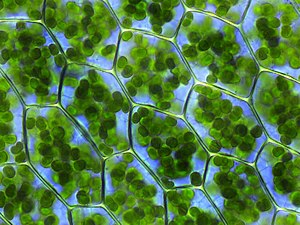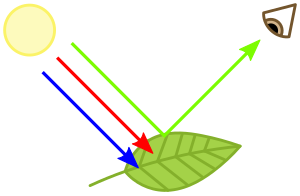chlorophyll
green pigment of plants found in chloroplasts. Captures the energy of the sun and is essential in photosynthesis.
Merriam-Webster Online Dictionary
chlorophyll (
noun)
1.
the green photosynthetic pigment found chiefly in the of plants and occurring especially as a blue-black ester CHMgNO or a dark green ester CHMgNO - chloroplasts 55 72 4 5 55 70 4 6 called also respectively chlorophyll a chlorophyll b
2.
a waxy green chlorophyll-containing substance extracted from green plants and used as a coloring agent or deodorant
Chlorophyll is responsible for the green color of many plants and algae.
Seen through a microscope, chlorophyll is concentrated within organisms in structures called
chloroplasts.
Plants are perceived as green because chlorophyll absorbs mainly the blue and red wavelength and reflects the green.
There are several types of chlorophyll, but all share the
chlorin magnesium ligand which forms the right side of this diagram.
Chlorophyll (also chlorophyl) is any of several related green pigments found in the mesosomes of cyanobacteria, as well as in the chloroplasts of algae and plants. Its name is derived from the Greek words χλωρός, chloros ("green") and φύλλον, phyllon ("leaf"). Chlorophyll is essential in photosynthesis, allowing plants to absorb energy from light.
Chlorophylls absorb light most strongly in the blue portion of the electromagnetic spectrum as well as the red portion. Conversely, it is a poor absorber of green and near-green portions of the spectrum, which it reflects, producing the green color of chlorophyll-containing tissues. Two types of chlorophyll exist in the photosystems of green plants: chlorophyll a and b.
ATP: Asia Tree Preservation2016-12-16T18:22:27+08:00
Share This Story, Choose Your Platform!




